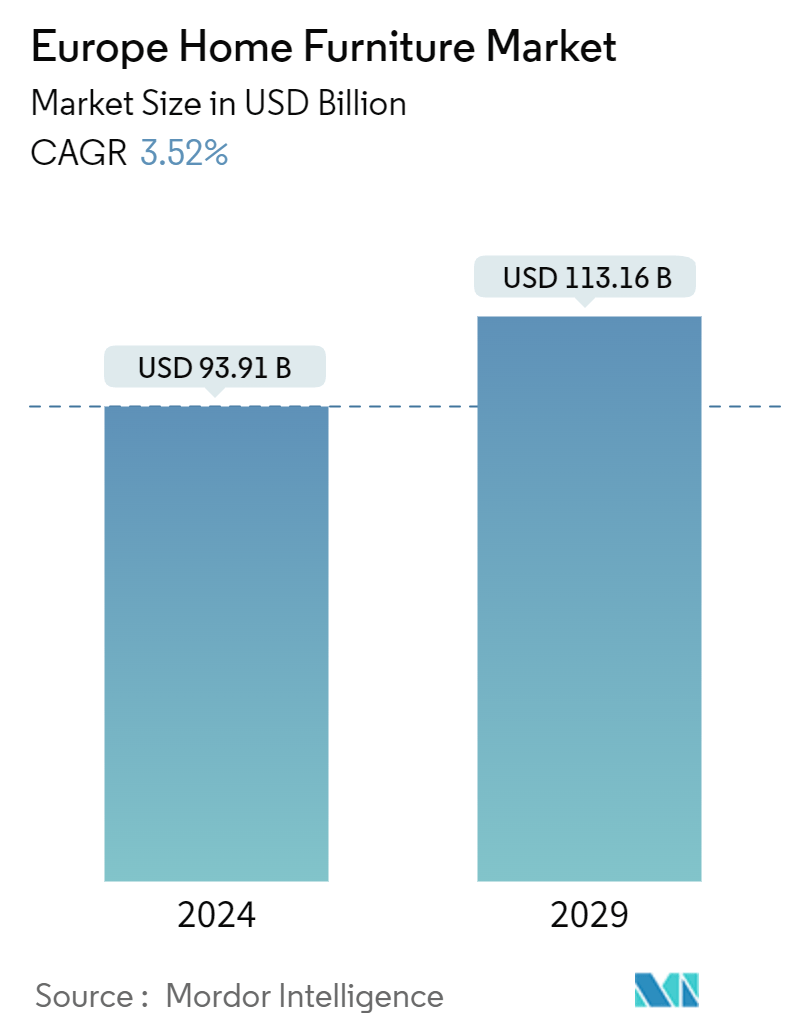Market Size of Europe Home Furniture Industry

| Study Period | 2020 - 2029 |
| Base Year For Estimation | 2023 |
| Market Size (2024) | USD 93.91 Billion |
| Market Size (2029) | USD 113.16 Billion |
| CAGR (2024 - 2029) | 3.52 % |
| Market Concentration | Low |
Major Players
*Disclaimer: Major Players sorted in no particular order |
Europe Home Furniture Market Analysis
The Europe Home Furniture Market size is estimated at USD 93.91 billion in 2024, and is expected to reach USD 113.16 billion by 2029, at a CAGR of 3.52% during the forecast period (2024-2029).
The growing demand for home furnishings in the region is a major factor behind Europe's growth. To reduce production costs and increase operational efficiency, market participants in this region have moved their manufacturing into other regions of the world. Europe accounts for one-fourth of the world's furniture production. Almost 15 % of the world's furniture production is done by Germany, the United Kingdom, Italy, and France.
Increased consumption is one of the main drivers for Europe's furniture market expansion. The future growth of the European furniture market will be driven by increasing demand for environmentally friendly, modern, and luxury furniture.
During the forecast period, the European home furniture market is expected to grow strongly. Some of the main factors that contribute to the market growth are rising disposable income, increasing building activity in the region, and growing urbanization. Strong economic growth and the development of regional demand trends have been observed in Eastern European countries. The growing trend of housing renovation and increasing demand for housing is being observed in Western European countries, such as Germany, the United Kingdom, France, etc.
Wooden furniture is in high demand in Europe due to the fast-growing real estate sector. Wooden furniture offers remarkable durability, eco-friendliness, comfort, mechanical resistance, and visual appeal. It also offers easy maintenance, modularity, high strength, stiffness, and sustainability. All of these factors will increase the demand for wood furniture in Europe.
Europe Home Furniture Industry Segmentation
Home furnishings are pieces of furniture that can be moved around the house or office to make it more comfortable to live and work in it.
The European furniture market is segmented by material, type, distribution channel, and country. The market is segmented by material type into wood, metal, plastic, and other furniture (glass, steel, particleboard, etc.). The market is segmented by type into kitchen, living room, dining room, and bedroom furniture. The market is segmented by distribution channel into supermarkets, hypermarkets, specialty stores, wholesalers, and online. By country, the market is segmented into Germany, the United Kingdom, France, Spain, and the Rest of Europe. The report offers market size and forecasts for the European home furniture market in value (USD) for all the above segments.
| By Material | |
| Wood | |
| Metal | |
| Plastic | |
| Other Materials |
| By Type | |
| Living Room Furniture | |
| Dining Room Furniture | |
| Bedroom Furniture | |
| Kitchen Furniture | |
| Other Furniture |
| By Distribution Channel | |
| Home Centers | |
| Specialty Stores | |
| Online | |
| Other Distribution Channels |
| By Country | |
| Germany | |
| United Kingdom | |
| Spain | |
| France | |
| Rest of Europe |
Europe Home Furniture Market Size Summary
The European home furniture market is poised for significant growth, driven by increasing demand for modern, luxury, and environmentally friendly furnishings. The region's robust economic conditions, rising disposable incomes, and urbanization are key factors propelling market expansion. The trend towards housing renovation and the burgeoning real estate sector, particularly in Western Europe, further bolster the demand for furniture, especially wooden varieties known for their durability and eco-friendliness. The integration of smart home technology into furniture design is also gaining traction, with innovations such as sofas with charging ports and remote-controlled beds becoming more popular. This fusion of technology and furniture aims to enhance convenience and modern living standards.
Germany stands out as a major player in the European furniture market, with its industry being one of the largest exporters within the EU. The German market is characterized by a preference for natural materials and innovative designs, particularly in the kitchen furniture sector. The ongoing construction and renovation activities, driven by urbanization and infrastructure development, are key contributors to the market's growth in Germany. Sustainability is a growing priority, with many manufacturers adopting eco-friendly practices and materials. The European home furniture market is fragmented, with a few dominant retailers like IKEA and Poltrona Frau, while the manufacturing and distribution segments are witnessing rapid consolidation. This dynamic landscape is shaped by strategic partnerships and collaborations, such as those between BoConcept and BIG, and Lumens and B&B Italia, which aim to redefine flexible and sustainable living spaces.
Europe Home Furniture Market Size - Table of Contents
-
1. MARKET DYNAMICS & INSIGHTS
-
1.1 Market Overview
-
1.2 Market Drivers
-
1.2.1 Adoption of Work from Home Culture Driving Market Demand
-
1.2.2 Increasing Urbanization and Changing Consumers Preferences Driving Market Growth
-
-
1.3 Market Restraints
-
1.3.1 Supply of Raw Material Can be Disrupted by Geopolitical Tensions
-
1.3.2 High Production Costs
-
-
1.4 Market Opportunities
-
1.4.1 Shoppers Using 3D Visuals for Purchasing the Furniture
-
-
1.5 Industry Value Chain Analysis
-
1.6 Porters 5 Force Analysis
-
1.6.1 Threat of New Entrants
-
1.6.2 Bargaining Power of Buyers/Consumers
-
1.6.3 Bargaining Power of Suppliers
-
1.6.4 Threat of Substitute Products
-
1.6.5 Intensity of Competitive Rivalry
-
-
1.7 Insights on technological innovations in the furniture industry
-
1.8 Insights on consumer preferences for furniture products in the country
-
1.9 Insights on key online players in the market
-
1.10 Impact of COVID 19 on the market
-
-
2. MARKET SEGMENTATION
-
2.1 By Material
-
2.1.1 Wood
-
2.1.2 Metal
-
2.1.3 Plastic
-
2.1.4 Other Materials
-
-
2.2 By Type
-
2.2.1 Living Room Furniture
-
2.2.2 Dining Room Furniture
-
2.2.3 Bedroom Furniture
-
2.2.4 Kitchen Furniture
-
2.2.5 Other Furniture
-
-
2.3 By Distribution Channel
-
2.3.1 Home Centers
-
2.3.2 Specialty Stores
-
2.3.3 Online
-
2.3.4 Other Distribution Channels
-
-
2.4 By Country
-
2.4.1 Germany
-
2.4.2 United Kingdom
-
2.4.3 Spain
-
2.4.4 France
-
2.4.5 Rest of Europe
-
-
Europe Home Furniture Market Size FAQs
How big is the Europe Home Furniture Market?
The Europe Home Furniture Market size is expected to reach USD 93.91 billion in 2024 and grow at a CAGR of 3.52% to reach USD 113.16 billion by 2029.
What is the current Europe Home Furniture Market size?
In 2024, the Europe Home Furniture Market size is expected to reach USD 93.91 billion.

